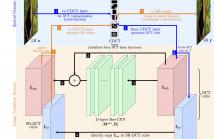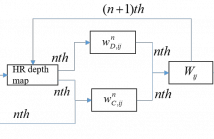
- Read more about A 203 FPS VLSI ARCHITECTURE OF IMPROVED DENSE TRAJECTORIES FOR REAL-TIME HUMAN ACTION RECOGNITION
- Log in to post comments
This paper introduces architecture with high throughput, low on-chip memory, and efficient data access for Improved Dense Trajectories (iDT) as video representations for real-time action recognition. The iDT feature can capture long-term motion cues better than any existing deep feature, which makes it crucial in state-of-the-art action recognition systems.
- Categories:
 14 Views
14 Views
- Read more about RATE-DISTORTION OPTIMIZED ILLUMINATION ESTIMATION FOR WAVELET-BASED VIDEO CODING
- Log in to post comments
We propose a rate-distortion optimized framework for estimating
illumination changes (lighting variations, fade in/out
effects) in a highly scalable coding system. Illumination
variations are realized using multiplicative factors in the image
domain and are estimated considering the coding cost
of the illumination field and input frames which are first
subject to a temporal Lifting-based Illumination Adaptive
Transform (LIAT). The coding cost is modelled by an L1-
norm optimization problem which is derived to approximate
- Categories:
 7 Views
7 Views
- Read more about ORTHOGONALLY REGULARIZED DEEP NETWORKS FOR IMAGE SUPER-RESOLUTION
- Log in to post comments
- Categories:
 10 Views
10 Views
Detecting and localizing anomalies in surveillance videos is an ongoing challenge. Most existing methods are patch or trajectory-based, which lack semantic understanding of scenes and may split targets into pieces. To handle this prob-lem, this paper proposes a novel and effective algorithm by incorporating deep object detection and tracking with full utilization of spatial and temporal information.
- Categories:
 93 Views
93 Views
- Read more about END-TO-END LOW-RESOURCE LIP-READING WITH MAXOUT CNN AND LSTM
- Log in to post comments
- Categories:
 15 Views
15 Views
- Read more about DEPTH SUPER-RESOLUTION USING JOINT ADAPTIVE WEIGHTED LEAST SQUARES AND PATCHING GRADIENT
- Log in to post comments
This paper presents a flexible framework for the challenging task of color-guided depth upsampling. Some state-of-the-art approaches apply an aligned RGB image for depth recovery. Unfortunately, these kinds of methods may result in texture copying artifacts and edge blurring artifacts. To address these difficulties, we propose an adaptive weighted least squares framework of choosing different guidance weight for variant conditions flexibly.
- Categories:
 49 Views
49 Views
- Read more about HARD SHADOWS REMOVAL USING AN APPROXIMATE ILLUMINATION INVARIANT
- Log in to post comments
Hard shadows detection and removal from foreground masks is a challenging step in change detection. This paper gives a simple and effective method to address hard shadows. There are inside portion and boundary portion in hard shadows. Pixel-wise neighborhood ratio is calculat¬ed to remove the most of inside shadow points. For the boundaries of shadow regions, we take advantage of color constancy to eliminate the edges of hard shadows and obtain relative accurate objects contours. Then, morphology processing is explored to enhance the integrity of objects.
- Categories:
 23 Views
23 Views
- Read more about Fusion of Multiple Multiband Images with Complementary Spatial and Spectral Resolutions
- Log in to post comments
- Categories:
 15 Views
15 Views
- Categories:
 27 Views
27 Views